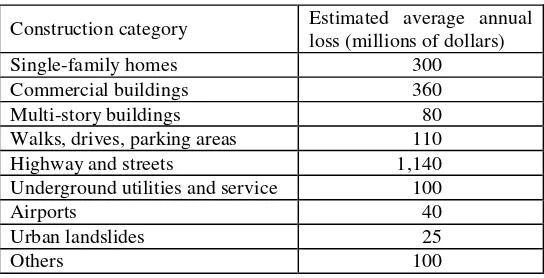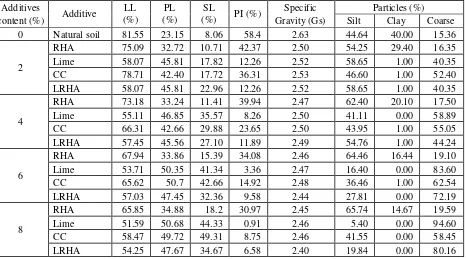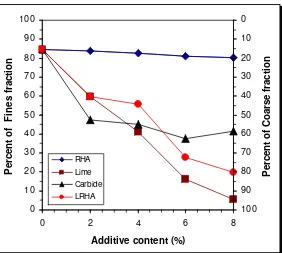Muntohar, A.S., and Abidin, Z., 2001, " A comparative study of different additive on the index properties of expansive soils ", Jurnal Semesta Teknika, Vol. 4 No. 2 November 2001 pp. 59-67.
A COMPARATIVE STUDY OF DIFFERENT ADDITIVE ON
THE INDEX PROPERTIES OF EXPANSIVE SOILS
Agus Setyo Muntohar 1, Zainal Abidin 2
ABSTRACT
Expansive soils pose a detrimental for any construction that rest upon this soil. This paper presents a comparative study of different additives on the index properties of expansive soils. Three additives are used. One is lime, and two others are waste materials, calcium carbide, and rice husk ash. A laboratory study consisted of the following tests on samples treated with stabilizer: Atterberg Limits, Particle Size, and Specific Gravity. It was found that the addition of 4 % additive be able minimize plasticity index and reduce clay particle of tested samples. The results confirmed that, however, lime is more effective as stabilizer, then calcium carbide, and RHA the latest.
Keywords: soil stabilization, expansive soils, index properties.
INTRODUCTION
Human have always realized that soil influences their survival. Soils is the ground on which human stand and build with soil. The study of expansive clay soils has attracted a great deal of attention in the last few years; since many countries are somehow affected by these soils, Indonesia being perhaps one very dramatic example. Besides the purely scientific interest in soils, the growth of the cities has led to dedicate more resources towards the investigation in this area, for it represents both a technological and social problem. For instance, some articles (Jones & Holtz, 1973) mentioned that the estimated damage, which could be attributed to soil expansion, amounts over 2,000 million dollars a year, as summarized in Table 1.
Table 1 Estimated damaged caused by expansive soils
Construction category Estimated average annual loss (millions of dollars)
Single-family homes 300
Commercial buildings 360
Multi-story buildings 80
Walks, drives, parking areas 110
Highway and streets 1,140
Underground utilities and service 100
Airports 40
Urban landslides 25
Others 100
In areas with expansive clays, the soils are generally stiff, and the chance of lightly loaded structures cracking due to settlement is rather remote. At the same time, there exist a large number of instances where heavy cracks have appeared in the basement walls that were not caused by foundation failure but by the earth pressure exerted on the wall, generally
1
compounded by seepage pressure. Many cases where vertical or horizontal cracks have developed in the basement wall, earth pressure problems are immediate suspects. In turn, diagonal cracks, which develop below windows and above doors, are a strong indication of swelling movement.
While it is true that swelling soils are probably responsible for most of the cracking and movement of lightly loaded structures, other aspects of foundation movement cannot and should not be ignored (Chen, 1975). The recent volcanic nature of most of the soft material In Indonesia sometimes means the presence of less weathered clay minerals, such as smectites
Areas with swelling soils can also be found, such as in Java hold the majority 60% (Younger, 1991). Generally, these soils have highly swelling and compressibility.
Therefore, due to all the problems generated by expansive soils when moisturized, several alternatives have already been suggested, among them the treatment of the soils by a number of materials. In recent years, researchers from many fields have attempted to solve the problems posed by industrial wastes. Finding a way for the utilisation of these wastes would be an advantageous way of getting free of them. Recent projects illustrated that successful waste utilisation could result in considerable savings in construction costs (Kamon & Nontananandh, 1991).
Accordingly, a comparative study of different materials, which have been proposed as stabilizing agents for expansive clays, is presented in this work. Two wastes materials, rice husk ash (RHA) and calcium carbide (CC), were studied and compared due to lime. It is an age – old practice to use lime in one form or the other to improve the engineering behaviour of expansive soils. Use of lime as admixtures for ground improvement has been in practice. This paper presents a comparative study of those additives on the index properties of expansive soils.
Measurement of expansive soils
Index properties refer to those properties of a soil that indicate the type and condition of the soil, and provide a relationship to structural properties, such as the strength and the compressibility or tendency for swelling and permeability.
The presence of even small amounts of certain clay minerals in a soil mass can have significant effect on the properties of the soil. Identifying the type and amount of clay minerals may be necessary in order to predict the soil’s behaviour or to develop methods for minimizing detrimental effects. Clay minerals can be identified using a variety of techniques. The most commonly employed techniques are: Mineralogy Identification, Indirect Methods
(Index properties, Potential Volume Change (PVC), Activity (Ac)) and Direct Methods
(Laboratory tests) (Nelson, et al, 1990).
The physical properties of expansive soils are (1) moisture content, (2) dry density, and (3) index properties. Table 2 is a guide for estimating the potential volume changes of expansive soils (Chen, 1975), reproduced here to aid comparisons.
Table 2 Data for making estimates of potential volume changes for expansive soils
EXPERIMENTAL STUDY
Materials Used
The soils carried out in this study are from the area of Ngramang, Kulon Progo region of D.I. Yogyakarta. According to the U.S.C.S. classification scheme; this soil is clay of high expansive potential. The properties of this soil are presented in Table 3.
Three different additives, RHA, lime, and calcium carbide, were used. The RHA was taken from rice husk burnt as fuel at brick combustion. The limes employed were hydrated lime type, commercially product. The calcium carbide used is waste from acetylene gas that makes use of welding process. The chemical constituent of each additive and soil is given in Table 4.
Table 3 Properties of natural soil
Properties Characteristics
Specific gravity (Gs) 2.63
Colour Black – grey
Table 4 Chemical constituent of soil sample and additives
Chemical
Note: the constituent is in % of mass.
Preparation of the Soil Mixtures
Four different percentages (2, 4, 6, and 8 %) of each stabilizing material were used. The percentage of additives content point to total content of stabilizing materials in mix was calculated in terms of the dry weight ("air-dry") of the soil. Especially, mixing between lime and RHA, labelled as LRHA, was blended at 2 % constant of lime.
Testing Program
Each blended was prepared to carry out some of the classification tests i.e. liquid limits, plastic limits, shrinkage limits, particle size distribution, and specific gravity.
RESULTS AND DISCUSSION
Measured Index Properties of Stabilized Soils
Table 5 contains the index properties obtained by evaluating the stabilized soils.
Table 5 Measured Index properties of stabilized soils
2.35
Figure 1 Specific gravity of stabilized soil as function of additive
Consistency limits
Figure 2 shows the plasticity index as a function of the stabilizing agent, this figure summarizes the results of the tests conducted in this study. It also indicates the properties of the untreated (natural) soil, for comparison.
0
Figure 2 Plasticity Index as function of percentage of stabilizing agent.
Calcium carbide demonstrates sharp reducing of plasticity. Basically, lime and calcium carbide – both are predominant hydrated lime. In the stabilization of soils with lime, for instance, this is used in form of quicklime, CaO, which reacts quickly with water, producing the moisturized lime, Ca(OH)2, and generating much heat and thus causing an increase of
volume:
CaO + H2O → Ca(OH)2 + 65.3 kJ/mol
This decreases considerably the plasticity index and the agglomeration effects, the contractions and expansions. The silica and the liberated aluminium combined with the lime to form silicates and aluminates of calcium. This crystallization, slow at the beginning, could last for very long time. The behaviour of the limes was similar (see Figure 1). At least at the 4 % of additives is enough to stabilize the soil. Overall consistency limits can be shown in
Figure 3 Consistency limits of stabilized soil
Particles size
0
Figure 4 Particles grain content of stabilized soil
0
Figure 5 Plasticity chart for classification of fines – grained soil
As mentioned in previous paragraph that index properties indirectly can measure or predict degree of expansion of soil. Lime proved a better effect to improve this expansive soil; in other word it is more effective than others. RHA, individually, has not much stabilized the soil. While, presence of RHA in 2 % lime, in this case, can enhance the role of lime as stabilizer. Further, calcium carbide also contributed to reduce degree of expansion although does not exhibit as better as lime. It can be precise that effectiveness the additives respectively lime, calcium carbide and the last is RHA. Combining RHA with lime give better result, than RHA.
It is an advantage to use waste materials such as RHA and calcium carbide for civil construction materials. Calcium carbide is the waste calcium oxide from acetylene production; there is reactivity loss during the time. The recommendation is applied after the production as soon as possible avoiding storage. Recycling those waste materials will reduce also environmental impact.
CONCLUSION AND RECOMMENDATION FOR STUDY
By comparing the three materials tested, one can conclude that traditional method by means of lime showed better result as stabilizer than calcium carbide and RHA. Even though, Calcium carbide was the one material that potential to stabilize the expansive soil. The admixture needs nearly the 4 – 6 % additives that enough to improve index properties of expansive soil. In this case, RHA was not effective as a soil stabilizer on index properties of expansive soils. However, presence of RHA into 2 % lime obviously enhanced the role of stabilizer than RHA individually react with soil. There is an advantage used recycling waste materials for civil construction materials, especially in geotechnical application. Indirectly, it can reduce environmental impact of waste materials.
It is also necessary to study mineralogy of soil and stabilized soil associated by X-Ray Diffraction, or SEM. A further test is needed to write a comprehensive conclusion.
ACKNOWLEGMENT
The author is thankful to Assoc. Prof. Ir. Dr. Roslan Hashim, Ph.D., P.E., MIEM (Department of Civil and Environmental Engineering, University of Malaya) who supported and encourage author. The support was given by Ir. Wahyu Widodo, MT., and Ir. Anita Widianti, MT., is also hearty thanks.
REFERENCES AND BIBLIOGRAPHY
Chen, R. H., 1975, Foundation on Expansive Soils, Elsevier Scientific Publishing, Netherlands.
Holtz, W.G., Hart, S.S., 1978, Home Construction on Shrinking and Swelling Soils, Colorado Geological Survey Publication SP-11, Denver, USA.
Jauberthie,R., Rendell, F., Tamba, S., Cisse I., 2000, Origin of the pozzolanic effect of rice husks, Journal of Construction and Building Material, Vol. 14, pp. 419 – 423.
Jones, D. E J., and Holtz, W. G., 1973, Expansive Soils – The Hidden Disaster, Civil Engineering, Aug. Vol. 43, Nov. 8
Muntohar, A.S., 2001, Swelling characteristics of expansive clay stabilized with LRHA, Proceeding National Seminar on the Engineering Science, Yogyakarta, pp. 62 – 68.
Kamon, M., Nantananadh, S., 1991, Combining industrial wastes with lime for soil stabilization, Journal Geotechnical Engineering Vol. 117 (1), pp. 1 – 17.
Nelson, John, D., Miller, Debora J., 1990, Expansive Soils, Problems and Practice in Foundation and Payment Engineering, John Wiley & Sons, Inc.
Payá, J., Monzó, J., Borrachero, M.V., Mellado, A., Ordoñez, L.M., 2001, Determination of amorphous silica in rice husk ash by rapid analytical method, Journal of Cement & Concrete Research, Vol. 31, pp. 212 – 231.






